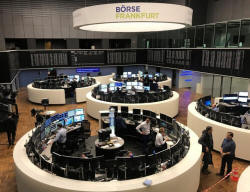Investors regain risk appetite as U.S. air strikes look
less imminent
 Send a link to a friend
Send a link to a friend
 [April 12, 2018]
By Helen Reid [April 12, 2018]
By Helen Reid
LONDON (Reuters) - European shares began to
recover on Thursday and Wall Street futures pointed to a positive U.S.
open, after U.S. President Trump signaled that military strikes in Syria
may not be imminent, and a strong U.S. earnings season came into focus.
The risk of clashes between Western powers and Russia in Syria over an
alleged chemical attack kept bond yields low, while crude prices fell
back, having surged to 2014 highs as a result of political risk in the
oil-rich region.
MSCI's world equity index <.MIWD00000PUS> was down for the second day
but European shares <.STOXX> managed a 0.4 percent gain as risky assets
regained the upper hand.
Minutes from the European Central Bank's March meeting changed little in
European trading, with investors waiting for speeches from ECB members
Coeure, Constancio and Weidmann later in the day.
Sentiment in European stocks improved ahead of Wall Street's open with
futures up 0.6 percent. <1YMc1> <ESc1> <NQc1>
Investors' expectations for very strong results from U.S. corporates in
the quarterly earnings season kept them from turning overly bearish on
stocks despite political risks.

The world's biggest asset manager, Blackrock <BLK.N>, kicked off the
earnings season with profit ahead of estimates.
Trump on Thursday amended an earlier warning of a swift military strike
on Syria, writing on Twitter "it could be very soon or not so soon at
all", sending the dollar <.DXY> higher.
Trump had declared on Wednesday that missiles "will be coming" in Syria,
taunting Russia for supporting Syrian President Bashar al-Assad after
the suspected chemical attack in Douma. Damascus and Moscow have denied
any responsibility.
His comments raised the prospect of direct conflict over Syria for the
first time between the two world powers backing opposing sides in the
seven-year-old civil war.
Heightened geopolitical tensions have piled pressure on investors
already rattled by a trade spat between the United States and China and
a generally more volatile market.
"We are seeing this regime shift take place in terms of drivers to
volatility," said Norman Villamin, chief investment officer of private
banking at UBP in Zurich.
Villamin expects the VIX <.VIX> gauge of S&P 500 volatility to stay
around the 20 mark - roughly twice its average level last year. The VIX
was last trading at its lowest level since April 6.
"If your portfolio today looks like it did last year, then you probably
haven't done enough to adapt your exposure," he said.

Crude prices fell back after three sessions of strong gains took them to
their highest levels since late 2014 on Wednesday.
[to top of second column] |

The German share price index, DAX board, is seen at the stock
exchange in Frankfurt, Germany, March 21, 2018. REUTERS/Tilman
Blasshofer

U.S. crude futures <CLc1> last traded down 0.7 percent at $66.35 a barrel,
having risen 7.4 percent so far this week. They traded as high as $67.45 on
Wednesday.
Brent <LCOc1> declined 0.8 percent to $71.53 a barrel, having touched a high of
$73.09 on Wednesday.
(For a graphic on 'Crude prices chart April 12' click https://reut.rs/2ILpqMy)
European government bond yields remained low as caution dominated ahead of ECB
minutes and speeches from several ECB members. Germany's 10-year Bund yield rose
1 basis point to 0.512, staying near the one-week low it hit on Wednesday.
"Investors are really torn on bonds right now because they know the economy is
strong and inflation is coming up," said UBP's Villamin.
He started adding to government bonds last month for the first time since 2016,
hoping to benefit from bonds' relatively low volatility.
Safe-haven gold <XAU=> slipped 0.6 percent from an 11-week high after minutes
from the Federal Reserve's policy meeting on Wednesday raised expectations it
could raise rates at a faster pace.
Risk appetite also returned to currency markets
The dollar index <.DXY> rose 0.3 percent to a session high after Trump's latest
comments, though it was still near a two-week low. The safe-haven yen <JPY=>
edged lower to 107.09 against the dollar.
The euro <EUR=> fell back 0.4 percent to $1.2329 ahead of the ECB meeting.
Russia's rouble edged up for a second day after heavy selling due to new
punitive sanctions by the United States.
It traded around 61.69 to the dollar <RUB=>, still down more than 7 percent this
week.

The Turkish lira <TRY=>, which has been highly sensitive to developments in
neighboring Syria, recovered slightly to trade at 4.1011 per dollar after
hitting a record low of 4.1920 on Wednesday.
The lira is down 2 percent so far this week, also hit by concern about inflation
and the central bank's reluctance to tighten its policy.
Worries about the Middle East have overshadowed budding optimism that Washington
and Beijing will work out a compromise to avert a trade war following a speech
by Chinese President Xi Jinping on Tuesday.
"Underneath the sabre-rattling, there's negotiations, so maybe that is a bit of
a buying opportunity," said Gill Lakin, chief investment officer at Brompton
Asset Management.
(Reporting by Helen Reid; Editing by Robin Pomeroy)
[© 2018 Thomson Reuters. All rights
reserved.] Copyright 2018 Reuters. All rights reserved. This material may not be published,
broadcast, rewritten or redistributed.
Thompson Reuters is solely responsible for this content. |